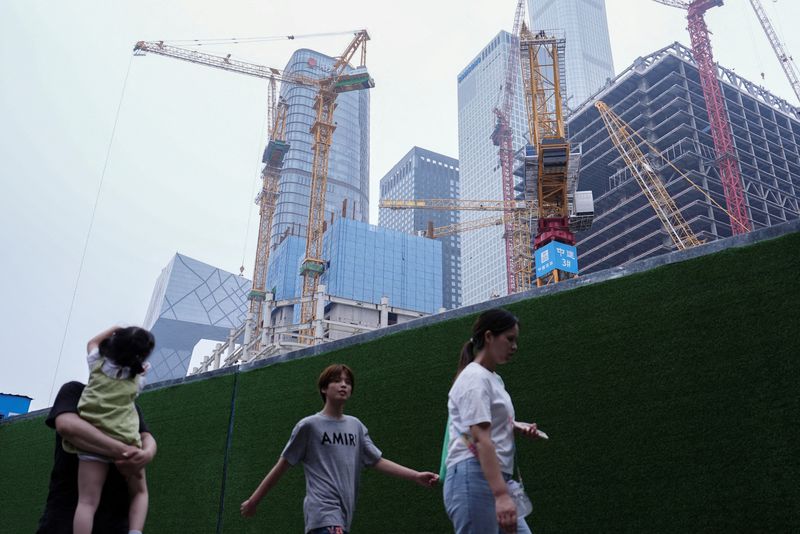By Joe Cash and Liangping Gao
BEIJING (Reuters) -Chinese officials acknowledged on Friday the sweeping list of economic goals re-emphasised at the end of a key Communist Party meeting this week contained "many complex contradictions," pointing to a bumpy road ahead for policy implementation.
Pressure for deep changes in how the world's second-largest economy functions has risen this year, with consumer and business sentiment near record lows domestically, and global leaders increasingly concerned with China's export dominance.
Following a four-day, closed-doors meeting led by President Xi Jinping, which takes place once in roughly five years, officials made a raft of seemingly contradictory pledges, from modernising the industrial complex while also expanding domestic demand to stimulating growth and simultaneously curbing debt risks.
The initial summary of the meeting, known as plenum, did not contain details on how Beijing plans to resolve the tensions between policy goals, such as how to get consumers to spend more while resources flow primarily to producers and infrastructure.
Concerns are growing that without a structural shift that gives consumers a greater role in the economy, debt will continue to outpace growth in order to finance Beijing's industrial modernisation and global prominence goals.
That raises the stakes. Some analysts warn the current path fuels risks of a prolonged period of near-stagnation and persistent deflation threats as seen in Japan since the 1990s.
"High debt levels plus increasing deflationary pressures eventually could result in a Japan-style ... low growth and very low inflation," said Julian Evans-Pritchard, head of China economics at Capital Economics.
"That, I think, would force them to change course on their current policies. But that might not happen straight away. That might only happen in a few years’ time."
Contradictions in Chinese policy efforts have been present for decades, as were goals to increase manufacturing value added, enhance social security, liberalise land use and improve local government tax revenues.
But making tough choices is an increasingly urgent task. China grew at a slower than expected pace in the second quarter, leaning hard on industrial output and external demand, but showing persistent domestic weakness.
Speaking at a media briefing on Friday along with other Party officials, Tang Fangyu, deputy director of the central committee's policy research office, acknowledged the challenges.
"The deeper the reform goes, the more complex and acute the conflicts of interest it touches," Tang said.
"Pushing forward Chinese-style modernisation faces many complex conflicts and problems, and we must overcome multiple difficulties and obstructions."
The European Union Chamber of Commerce in China said it was "positive that China’s leadership has again acknowledged many of the headwinds facing the country’s economy," but noted the outcome was largely "a reiteration of points."
"There appears to be no deviation from (China's) immediate priority, which is to balance its economic recovery against national security concerns, while maintaining social stability."
'DISAPPOINTING'
China is expected to publish a document with more detailed policy plans in the coming days.
But the fact that the initial post-plenum announcement borrowed heavily from China's existing playbook disappointed some economists.
“Nothing new under the sun: the same industrial policies, the same sense of things," said Alicia Garcia Herrero, chief economist Asia-Pacific at Natixis.
"Really no change in direction, no consumption-led growth, nothing. No sentence on the power of market forces, nothing. So, it’s really disappointing.”
Chinese stocks, not far above the five-year lows hit at the start of 2024, were flat on Friday, suggesting the plenum did little to improve sentiment.
After a similar plenum in 2013, Beijing launched a policy agenda that included most of the goals announced on Thursday, but also ambitions to liberalise financial markets and make domestic consumption a more prominent driver of growth.
A capital outflows scare in 2015 halted many of these plans. Many analysts argue that national security considerations have pushed China in the opposite direction in recent years, tightening control over swathes of the economy with regulatory crackdowns on industries including tech and finance.
Instead of leaning on household demand, Beijing had poured resources into infrastructure and real estate, which led many local governments across the country to accumulate debt at an unsustainable pace.
Beijing has recently highlighted advanced manufacturing as a new growth driver, again sidestepping consumers, with leaders hoping an industrial leap could save China from the middle-income trap and stabilise the job market in the process.
The plenum reasserted China's quest for "new productive forces", a term coined by Xi last year that envisions scientific research and technological breakthroughs for industrial expansion.

"There is still tension between expanding the supply side of the economy and boosting household spending," said Harry Murphy Cruise, an economist at Moody’s Analytics.
"The communique mostly focused on ‘new productive forces’, ‘the scientific and technological revolution’, and ‘industrial transformation. Mention of support to household wellbeing didn’t come until the tail end."